Basic operation guide for Google OAuth users in CubeBackup
Basic operations for end users
CubeBackup for Google Workspace supports Google OAuth login and can serve as a backup portal for end users. After successfully signing in with your Google accounts, the backup snapshots will be displayed in the MY BACKUPS and SHARED DRIVES page. All operations can be easily monitored in the HISTORY page.
Restore
CubeBackup is designed to keep a version history of all of your data, including entire folder structures, making it easy to restore to an earlier point in time. For example, you can turn back the clock on an entire project, restoring all files and folders to the exact state they were in two months ago.
Restore Google Drive files or folders
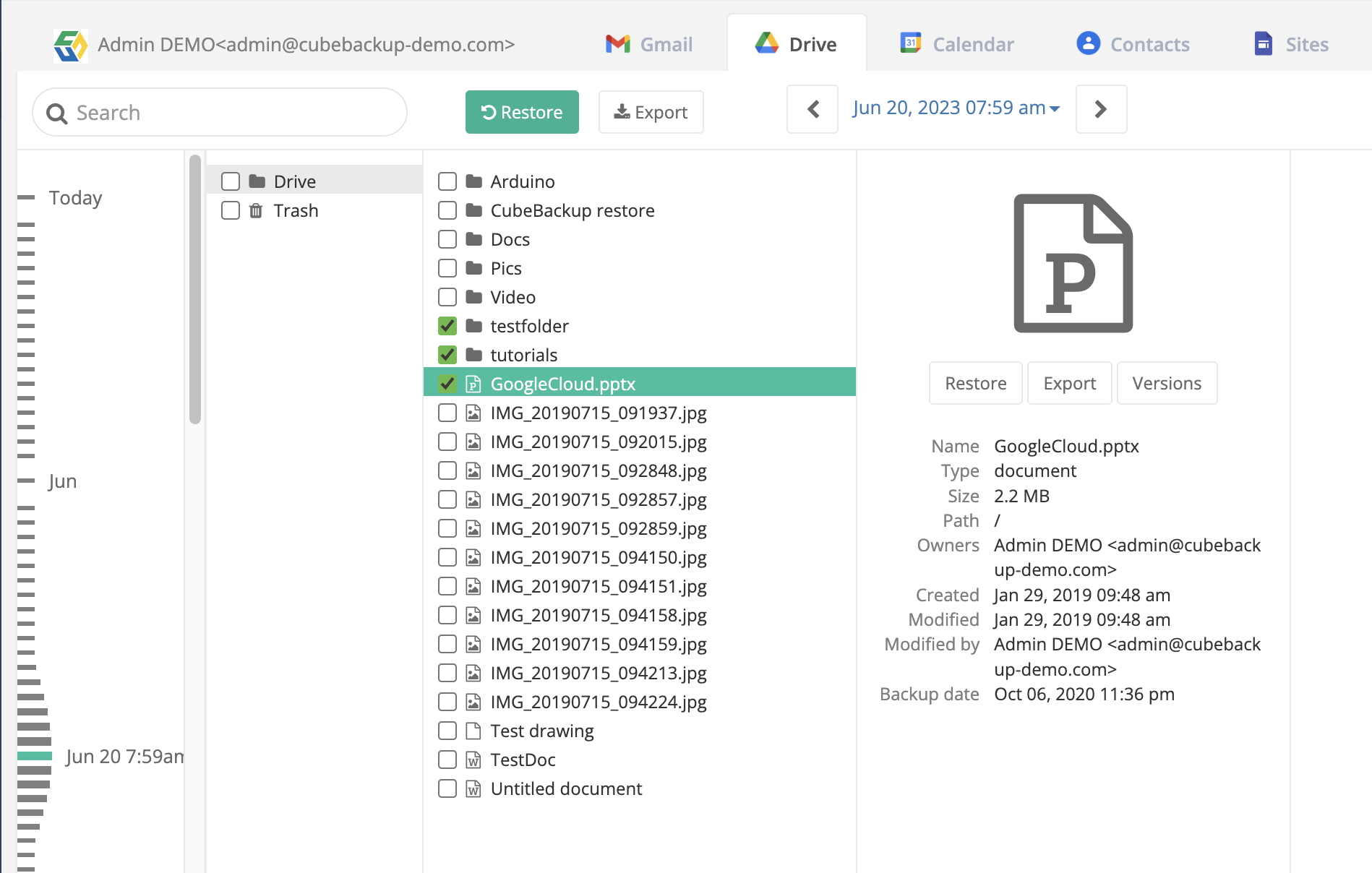
- Click the Drive tab on the MY BACKUPS page.
- To restore a single file:
- Find the file by browsing through the Drive structure, or use the search box.
- Click on the file to display detailed information, including filename, size, and backup date.
- Click the Versions button to list all available revisions of the file.
- Select the version to restore and click the Restore button to restore it to Google Drive, or click on the Export button to download the file.
- To restore multiple files or folders:
- The timeline in the left panel shows the available snapshots, each representing the state of your entire Google Drive at that moment in time. Use the timeline to select the point in the version history you would like to return to.
- Select the files and folders you'd like to restore, using the search box if necessary.
- Click the Restore button to restore it to your Google Drive, or click the Export button to download the files.
- By default, restored Google Drive files and folders will be placed in a folder named Restored <date-time>. You can also input a specific folder name instead.
Restore Shared drives files or folders
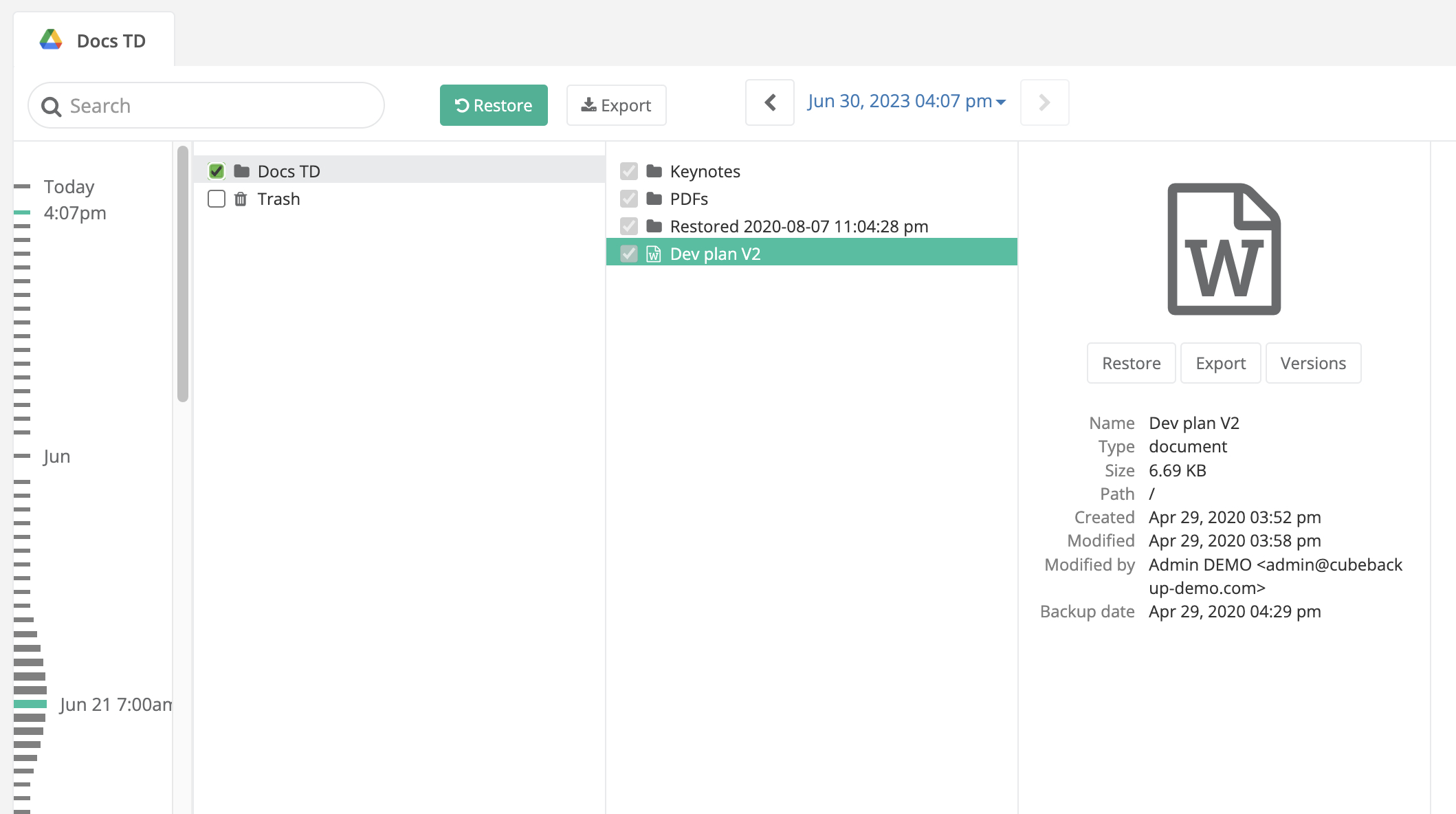
- Select the SHARED DRIVES page from the left panel.
- Select the Shared drive whose data needs to be restored, using the search box if necessary.
- To restore a single file:
- Find the file by browsing through the Shared drive structure, or use the search box.
- Click on the file to display detailed information, including filename, size, and backup date.
- Click the Versions button to list all available revisions of the file.
- Select the version to restore and click the Restore button, or click the Export button to download the file.
- To restore multiple files or folders:
- The timeline in the left panel shows the available snapshots, each representing the state of your entire Shared drive at that moment in time. Use the timeline to select the point in the version history you would like to return to.
- Select the files and folders you would like to restore, using the search box if necessary.
- Click the Restore button, or click the Export button to download the file.
- By default, restored Shared drive files and folders will be placed in a folder named Restored <date-time>. You can also input a specific folder name instead.
Restore Gmail messages
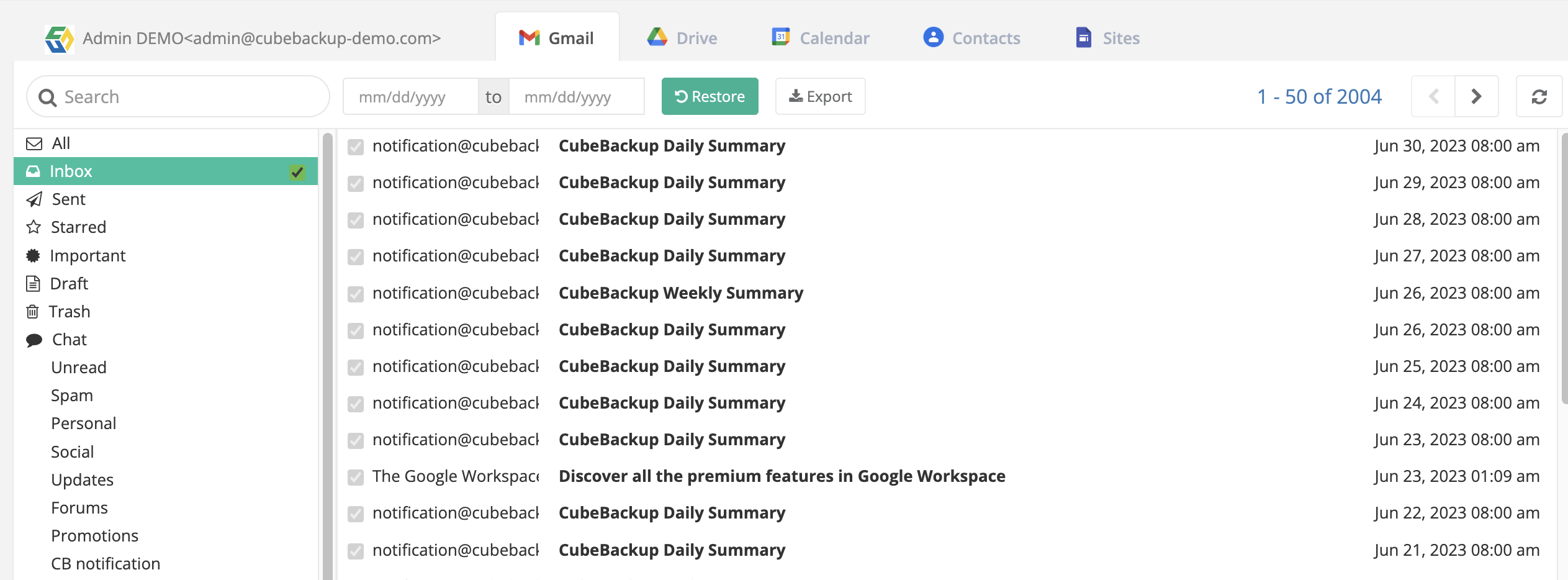
- Click the Gmail tab on the MY BACKUPS page.
- To restore mail messages:
- Select the messages you want to restore. You can filter messages using the search box or the date controls at the top of the page, or also by Gmail labels.
- Click the Restore button, or click the Export button to download the emails as Mbox files.
Messages restored to a user's Gmail account will have all original labels and timestamps preserved. By default, CubeBackup will also add a label that lists the date and time of restoration (i.e.: Restored 2022-06-11 10:15:02 am), or you can specify a target label instead.
For example, if a message was originally labelled "INBOX" and "Team" when it was backed up, when restored, it will now have three labels: "INBOX", "Team", and either "Restored 2022-06-11 10:15:02 am" or a custom label of your choosing.
Restore Google Contacts
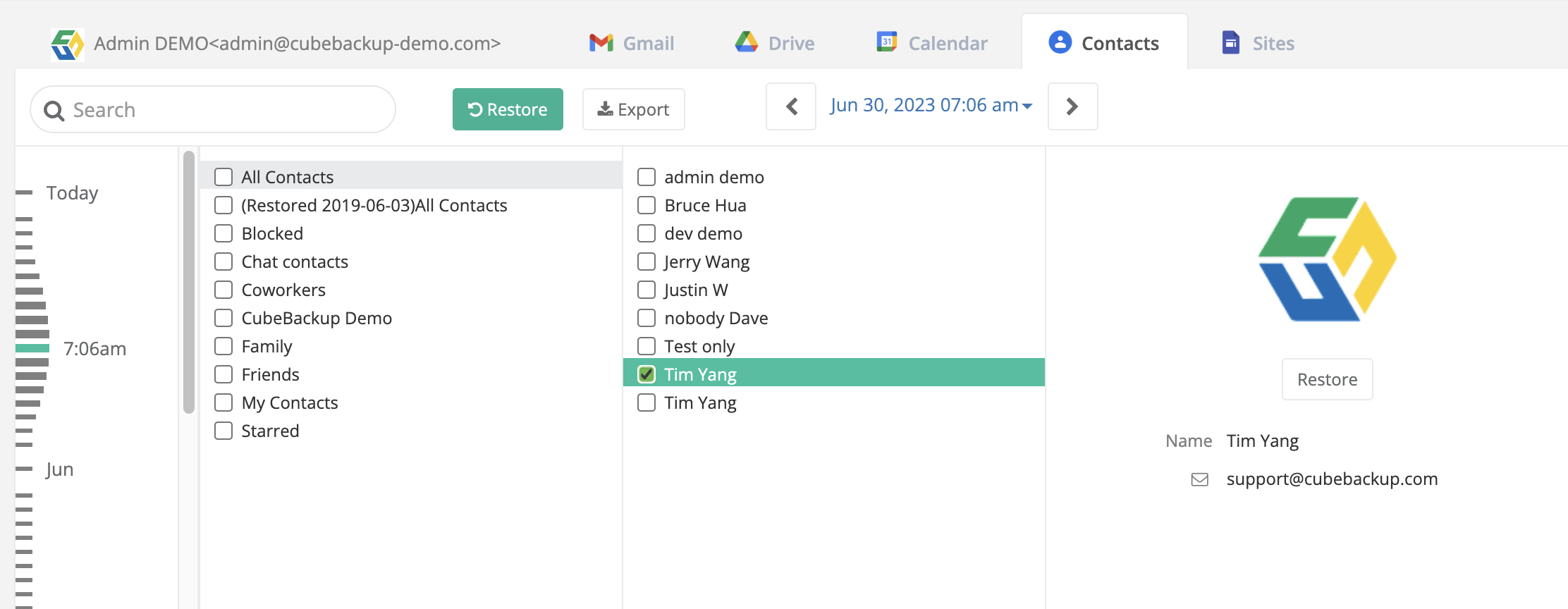
- Click the Contacts tab on the MY BACKUPS page.
- The timeline in the left panel shows the available snapshots, each representing the state of your entire Google Contacts at that moment in time. Use the timeline to select the point in the version history you would like to return to.
- Select the contacts or groups you would like to restore, using the search box if necessary.
- Click the Restore button, or click the Export button to download the contacts.
- A new group named Restored <date-group_name> is created in your Google Contacts, containing the restored contacts.
Restore Google Calendar Events
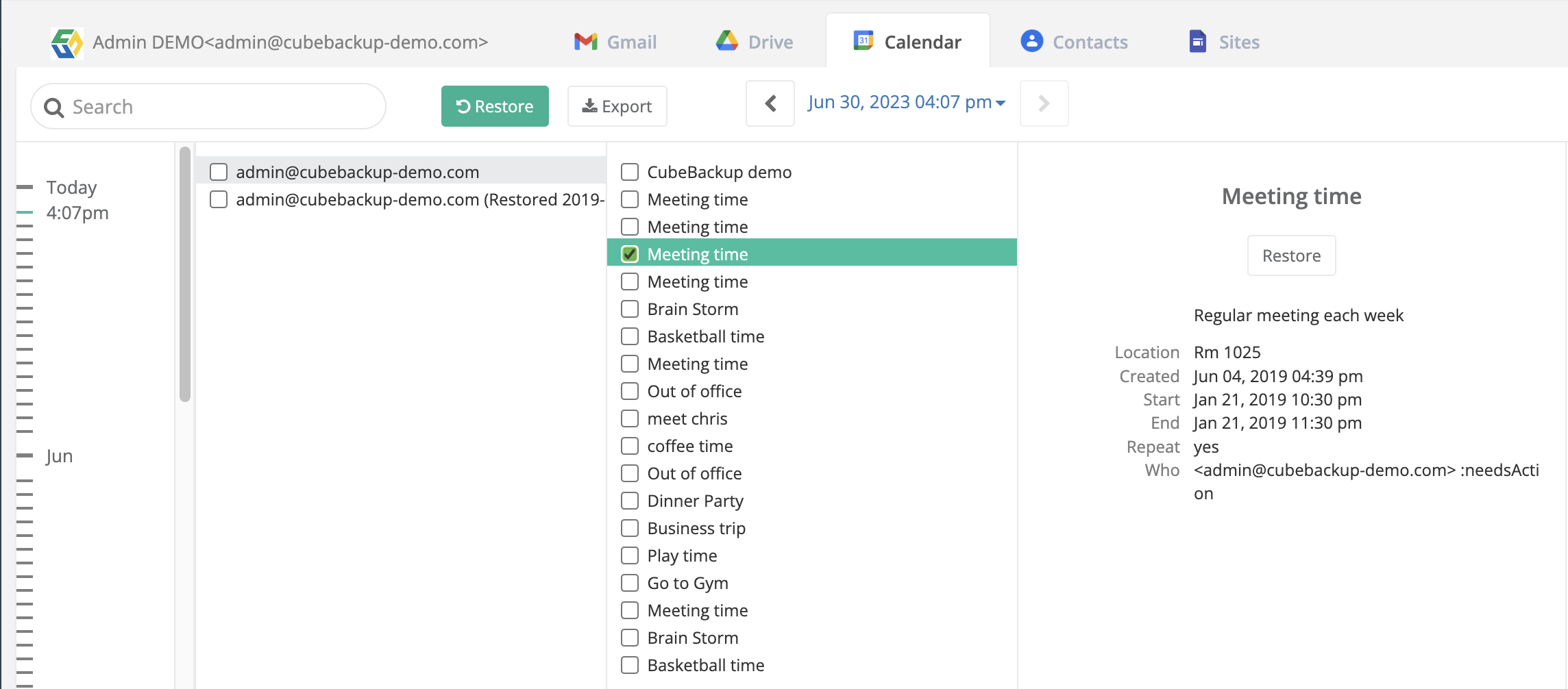
- Click the Calendar tab on the MY BACKUPS page.
- The timeline in the left panel shows the available snapshots, each representing the state of all Google Calendars belonging to that user (and all Calendars shared with that user) at that moment in time. Use the timeline to select the point in the version history you would like to return to.
- Select the events or calendars you would like to restore, using the search box to find events, if necessary.
- Click the Restore button, or click the Export button to download the calendar events.
- A new calendar named Restored <date-time> is created in your Google Calendar, containing the restored events.
NOTE: CubeBackup only backs up your own calendars. System calendar (e.g. Birthdays, Holidays) and calendars shared from others are not included in the backups.
View history
The HISTORY page displays the Restore and Export logs so you can easily monitor recent activities. Each time an action is performed, CubeBackup will add a log entry to this page. Separate tabs track entries for Restore and Export actions.

The controls at the top of each tab can also be used to filter the list by description and date. Clicking the links under the Files column will open a pop-up window showing the individual items that were restored or exported for that entry. You can also filter this list or export it to a CSV file.
Actions that have given an error will be highlighted in Warning in the list. The list can also be set to only display errors by clicking the Show only errors box. Clicking the Warning or Failed entry under Status or Errors will open a pop-up box detailing the error messages for that action. If you need assistance, these detailed messages can be copied or exported to a CSV file and sent to [email protected] for help.
